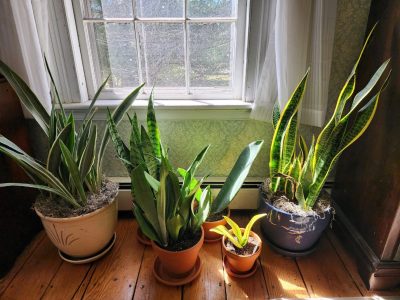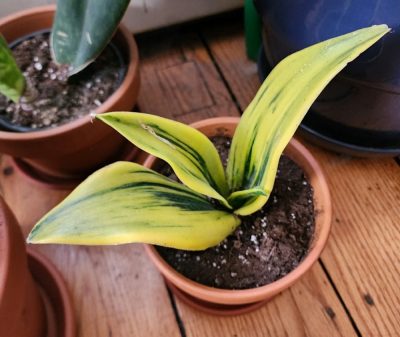By Dr. Matthew Lisy, UConn Adjunct Faculty

The Sansevieria group make up some of my favorite houseplants. Scientists recently placed them in the genus Dracaena, but its former scientific name seems to be also one of its common names. This plant has many common names including “snake plant” and my personal favorite “mother-in-law’s tongue”. Like many varieties of houseplant, there are some staples that have been around for decades, some newer species that have come to market, and some really interesting cultivars.
These plants have a rhizome, and the leaves grow from the base of your pot. They are very prolific when they like their environment. In fact, they tend to break the pots they are in, so I would recommend using plastic pots, which their growth will eventually deform. If you want to use a clay or ceramic pot, I suggest putting them in a slightly smaller plastic pot, then putting that in the clay pot. You can hide the gap between the two pots with Spanish moss. Being native to Africa, they cannot tolerate cold temperatures. Typical household temperatures work well, but avoid anything below 55 degrees F.
Their upright growth habit allows the grower to have many varieties in a small area.
Overwatering is the quickest way to kill any houseplant, but especially so with these. In the winter, you probably only want to water once a month, and sparingly at that. Do not let them get soggy or this otherwise hardy plant will rot. In the warmer months when the plant is actively growing, allow the soil to dry between waterings, but then water more liberally. These plants have the reputation of being a low light plant, which they certainly can handle. Sometimes people place them in the darkest corner where they hang on for a few months, but then eventually run out of stored resources and die. Remember they do need some light to photosynthesize so bright indirect light is best. The other problem I have seen is their unique, flat leaves can become covered in dust. Either dust them manually, use a blower, or take them outside in warm weather and hose them off.

The Sansevieria group can be divided into two types, those with flat leaves and those with cylindrical leaves. Of those groups, there are species that grow tall and some that grow short.
The tall ones make great floor plants while the shorter ones do well when placed on a table. All varieties are fairly easy to propagate. My favorite way is to let the plant grow, and then divide them during repotting; this looks the best in my opinion. If you want more plants quicker, you can take leaf cuttings. Either dip in rooting hormone and replant, or you can place the cuttings in water to take root (change the water daily for best results).
Most of us are familiar with the green and dark green snake plant, as well as the gold edged version. There are some absolutely stunning new varieties on the market today that have selected for any of those colors. For example, there is one called “Moonshine,’ which has no pattern in the leaf at all, instead being pale green. Another interesting one is called ‘Hi Color,’ which has more yellow than green in the leaves. There are others that are selected for their rather dark green hue that approaches black in color. One of my new favorites is a different species called Sansevieria masoniana, commonly referred to as “whale tail”, “shark fin”, or some combination thereof. No matter which one you choose, you really cannot go wrong with these plants. They are readily available at most garden and home centers, so why not pick one up and brighten up your home?
For your gardening questions, feel free to contact us, toll-free, at the UConn Home & Garden Education Center at (877) 486-6271, visit our website at www.homegarden.cahnr.uconn.edu or contact your local Cooperative Extension center.